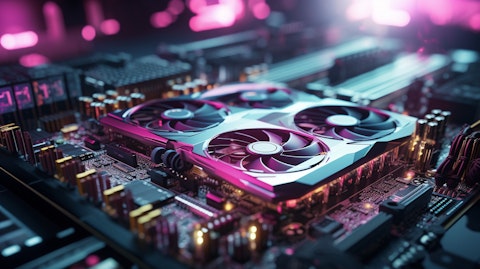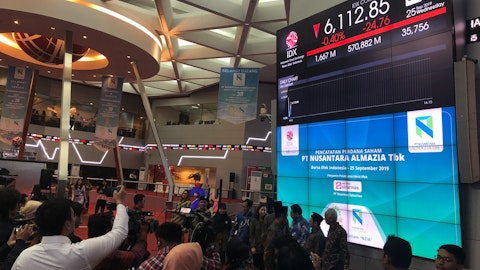NVIDIA Corporation (NASDAQ:NVDA) Q4 2024 Earnings Call Transcript February 21, 2024
NVIDIA Corporation beats earnings expectations. Reported EPS is $5.16, expectations were $4.54. NVDA isn’t one of the 30 most popular stocks among hedge funds at the end of the third quarter (see the details here).
Operator: Good afternoon. My name is Rob and I’ll be your conference operator today. At this time, I would like to welcome everyone to the NVIDIA’s Fourth Quarter Earnings Call. All lines have been placed on mute to prevent any background noise. After the speaker’s remarks, there will be a question-and-answer session. [Operator Instructions] Thank you. Simona Jankowski, you may begin your conference.
Simona Jankowski: Thank you. Good afternoon, everyone, and welcome to NVIDIA’s conference call for the fourth quarter and fiscal 2024. With me today from NVIDIA are Jen-Hsun Huang, President and Chief Executive Officer, and Colette Kress, Executive Vice President and Chief Financial Officer. I’d like to remind you that our call is being webcast live on NVIDIA’s Investor Relations website. The webcast will be available for replay until the conference call to discuss our financial results for the first quarter of fiscal 2025. The content of today’s call is NVIDIA’s property. It can’t be reproduced or transcribed without our prior written consent. During this call, we may make forward-looking statements based on current expectations.
These are subject to a number of significant risks and uncertainties and our actual results may differ materially. For a discussion of factors that could affect our future financial results and business, please refer to the disclosure in today’s earnings release, our most recent Forms 10-K and 10-Q and the reports that we may file on Form 8-K with the Securities and Exchange Commission. All our statements are made as of today, February 21, 2024, based on information currently available to us. Except as required by law, we assume no obligation to update any such statements. During this call, we will discuss non-GAAP financial measures. You can find a reconciliation of these non-GAAP financial measures to GAAP financial measures in our CFO commentary, which is posted on our website.
With that let me turn the call over to Colette.
Colette Kress: Thanks, Simona. Q4 was another record quarter. Revenue of $22.1 billion was up 22% sequentially and up to 265% year-on-year and well above our outlook of $20 billion. For fiscal 2024, revenue was $60.9 billion and up 126% from the prior year. Starting with data center. Data center revenue for the fiscal 2024 year was $47.5 billion, more than tripling from the prior year. The world has reached the tipping point of new computing era. The $1 trillion installed base of data center infrastructure is rapidly transitioning from general purpose to accelerated computing. As Moore’s Law slows while computing demand continues to skyrocket, companies may accelerate every workload possible to drive future improvement in performance, TCO and energy efficiency.
At the same time, companies have started to build the next generation of modern data centers, what we refer to as AI factories, purpose built to refine raw data and produce valuable intelligence in the era of generative AI. In the fourth quarter, data center revenue of $18.4 billion was a record, up 27% sequentially and up 409% year-over-year, driven by the NVIDIA Hopper GPU computing platform along with InfiniBand end-to-end networking. Compute revenue grew more than 5x and networking revenue tripled from last year. We are delighted that supply of Hopper architecture products is improving. Demand for Hopper remains very strong. We expect our next-generation products to be supply constrained as demand far exceeds supply. Fourth quarter data center growth was driven by both training and inference of generative AI and large language models across a broad set of industries, use cases and regions.
The versatility and leading performance of our data center platform enables a high return on investment for many use cases, including AI training and inference, data processing and a broad range of CUDA accelerated workloads. We estimate in the past year approximately 40% of data center revenue was for AI inference. Building and deploying AI solutions has reached virtually every industry. Many companies across industries are training and operating their AI models and services at scale, enterprises across NVIDIA AI infrastructure through cloud providers, including hyperscales, GPU specialized and private clouds or on-premise. NVIDIA’s computing stack extends seamlessly across cloud and on-premise environments, allowing customers to deploy with a multi-cloud or hybrid-cloud strategy.
In the fourth quarter, large cloud providers represented more than half of our data center revenue, supporting both internal workloads and external public cloud customers. Microsoft recently noted that more than 50,000 organizations use GitHub Copilot business to supercharge the productivity of their developers, contributing to GitHub revenue growth accelerating to 40% year-over-year. And Copilot for Microsoft 365 adoption grew faster in its first two months than the two previous major Microsoft 365 enterprise suite releases did. Consumer internet companies have been early adopters of AI and represent one of our largest customer categories. Companies from search to e-commerce, social media, news and video services and entertainment are using AI for deep learning-based recommendation systems.
These AI investments are generating a strong return by improving customer engagement, ad conversation and click-throughs rates. Meta in its latest quarter cited more accurate predictions and improved advertiser performance as contributing to the significant acceleration in its revenue. In addition, consumer internet companies are investing in generative AI to support content creators, advertisers and customers through automation tools for content and ad creation, online product descriptions and AI shopping assistance. Enterprise software companies are applying generative AI to help customers realize productivity gains. Early customers we’ve partnered with for both training and inference of generative AI are already seeing notable commercial success.
ServiceNow’s generative AI products in their latest quarter drove their largest ever net new annual contract value contribution of any new product family release. We are working with many other leading AI and enterprise software platforms as well, including Adobe, Databricks, Getty Images, SAP and Snowflake. The field of foundation of large-language models is thriving. Anthropic, Google, Inflection, Microsoft, OpenAI and xAI are leading with continued amazing breakthrough in generative AI. Exciting companies like Adept, AI21, Character.ai, Cohere, Mistral, Perplexity and Runway are building platforms to serve enterprises and creators. New startups are creating LLMs to serve the specific languages, cultures and customs of the world many regions.
And others are creating foundation models to address entirely different industries like Recursion Pharmaceuticals and Generate:Biomedicines for biology. These companies are driving demand for NVIDIA AI infrastructure through hyperscale or GPU specialized cloud providers. Just this morning, we announced that we’ve collaborated with Google to optimize its state-of-the art new Gemma language models to accelerate their inference performance on NVIDIA GPUs in the cloud data center and PC. One of the most notable trends over the past year is the significant adoption of AI by enterprises across the industry verticals such as automotive, healthcare and financial services. NVIDIA offers multiple application frameworks to help companies adopt AI in vertical domains such as autonomous driving, drug discovery, low latency machine learning for fraud detection or robotics, leveraging our full stack accelerated computing platform.
We estimate the data center revenue contribution of the automotive vertical through the cloud or on-prem exceeded $1 billion last year. NVIDIA DRIVE infrastructure solutions includes systems and software for the development of autonomous driving, including data ingestion, creation, labeling and AI training, plus validation through simulation. Almost 80 vehicle manufacturers across global OEMs, new energy vehicles, trucking, robotaxi and Tier 1 suppliers are using NVIDIA’s AI infrastructure to train LLMs and other AI models for automated driving and AI cockpit applications. And in fact, nearly every automotive company working on AI is working with NVIDIA. As AV algorithms move to video transformers and more cars are equipped with cameras, we expect NVIDIA’s automotive data center processing demand to grow significantly.

In healthcare, digital biology and generative AI are helping to reinvent drug discovery, surgery, medical imaging and wearable devices. We have built deep domain expertise in healthcare over the past decade, creating the NVIDIA Clara healthcare platform and NVIDIA BioNeMo, a generative AI service to develop, customize and deploy AI foundation models for computer-aided drug discovery. BioNeMo features a growing collection of pre-trained Biomolecular AI models that can be applied to the end-to-end drug discovery processes. We announced Recursion is making available for their proprietary AI model through BioNeMo for the drug discovery ecosystem. In financial services, customers are using AI for a growing set of use cases from trading and risk management to customer service and fraud detection.
For example, American Express improved fraud detection accuracy by 6% using NVIDIA AI. Shifting to our data center revenue by geography. Growth was strong across all regions, except for China where our data center revenue declined significantly following the U.S. government export control regulations imposed in October. Although we have not received licenses from the U.S. government to ship restricted products to China, we have started shipping alternatives that don’t require a license for the China market. China represented a mid-single digit percentage of our data center revenue in Q4. And we expect it to stay in a similar range in the first-quarter. In regions outside of the U.S. and China, sovereign AI has become an additional demand driver.
Countries around the world are investing in AI infrastructure to support the building of large-language models in their own language, on domestic data and in support of their local research and enterprise ecosystems. From a product perspective, the vast majority of revenue was driven by our Hopper architecture along with InfiniBand networking. Together, they have emerged as the de-facto standard for accelerated computing and AI infrastructure. We are on track to ramp H200 with initial shipments in the second quarter. Demand is strong as H200 nearly doubles the inference performance of H100. Networking exceeded a $13 billion annualized revenue run rate. Our end-to-end networking solutions define modern AI data centers. Our Quantum InfiniBand solutions grew more than 5x year on year.
NVIDIA Quantum InfiniBand is the standard for the highest performance AI-dedicated infrastructures. We are now entering the ethernet networking space with the launch of our new Spectrum-X end-to-end offering designed for an AI-optimized networking for the data center. Spectrum-X introduces new technologies over ethernet, that are purpose built for AI. Technologies incorporated in our Spectrum switch, BlueField DPU and software stack deliver 1.6x higher networking performance for AI processing compared with traditional ethernet. Leading OEMs, including Dell, HPE, Lenovo and Super Micro, with their global sales channels, are partnering with us to expand our AI solution to enterprises worldwide. We are on track to ship Spectrum-X this quarter.
We also made great progress with our software and services offerings, which reached an annualized revenue run rate of $1 billion in Q4. We announced that NVIDIA DGX Cloud will expand its list of partners to include Amazon’s AWS, joining Microsoft Azure, Google Cloud and Oracle Cloud. DGX Cloud is used for NVIDIA’s own AI R&D and custom model development as well as NVIDIA developers. It brings the CUDA ecosystem to NVIDIA CSP partners. Okay, moving to gaming. Gaming revenue was $2.87 billion, was flat sequentially and up 56% year on year, better than our outlook on solid consumer demand for NVIDIA GeForce RTX GPUs during the holidays. Fiscal year revenue of $10.45 billion was up 15%. At CES, we announced our GeForce RTX 40 Super Series family of GPUs. Starting at $599, they deliver incredible gaming performance and generative AI capabilities.
Sales are off to a great start. NVIDIA AI Tensor cores and the GPUs deliver up to 836 AI tops, perfect for powering AI for gaming, creating an everyday productivity. The rich software stack we offer with our RTX GPUs further accelerates AI. With our DLSS technologies, seven out of eight pixels can be AI generated, resulting up to 4x faster ray tracing and better image quality. And with the Tensor RT LLM for Windows, our open-source library that accelerates inference performance for the latest large-language models generative AI can run up to 5X faster on RTX AI PCs. At CES, we also announced a wave of new RTX 40 Series AI laptops from every major OEMs. These bring high-performance gaming and AI capabilities to a wide range of form factors, including 14 inch and thin and light laptops.
With up to 686 tops of AI performance, these next-generation AI PCs increase generative AI performance by up to 60x, making them the best-performing AI PC platforms. At CES, we announced NVIDIA Avatar Cloud Engine microservices, which allowed developers to integrate state-of-the-art generative AI models into digital avatars. ACE won several Best of CES 2024 awards. NVIDIA has an end-to-end platform for building and deploying generative AI applications for RTX PCs and workstations. This includes libraries, SDKs, tools and services developers can incorporate into their generative AI workloads. NVIDIA is fueling the next wave of generative AI applications coming to the PC. With over 100 million RTX PCs in the installed-base and over 500 AI-enabled PC applications and games, we are on our way.
Moving to Pro Visualization. Revenue of $463 million was up 11% sequentially and up 105% year on year. Fiscal year revenue of $1.55 billion was up 1%. Sequential growth in the quarter was driven by a rich mix of RTX Ada architecture GPUs continuing to ramp. Enterprises are refreshing their workstations to support generative AI-related workloads, such as data preparation, LLM fine-tuning and retrieval augmented generation. These key industrial verticals driving demand include manufacturing, automotive and robotics. The automotive industry has also been an early adopter of NVIDIA Omniverse as it seeks to digitize work flows from design to build, simulate, operate and experience their factories and cars. At CES, we announced that creative partners and developers including Brickland, WPP and ZeroLight are building Omniverse-powered car configurators.
Leading automakers like LOTUS are adopting the technology to bring new levels of personalization, realism and interactivity to the car buying experience. Moving to Automotive. Revenue was $281 million, up 8% sequentially and down 4% year on year. Fiscal year revenue of $1.09 billion was up 21%, crossing the $1 billion mark for the first time on continued adoption of the NVIDIA DRIVE platform by automakers. NVIDIA DRIVE Orin is the AI car computer of choice for software-defined AV fleets. Its successor, NVIDIA DRIVE Thor, designed for vision transformers often — offers more AI performance and integrates a wide range of intelligent capabilities into a single AI compute platform, including autonomous driving and parking, driver and passenger monitoring and AI cockpit functionality and will be available next year.
There were several automotive customer announcements this quarter, Li Auto, Great Wall Motor, ZEEKR, the premium EV subsidiary of Geely and Jeremy Xiaomi EV all announced new vehicles built on NVIDIA. Moving to the rest of the P&L. GAAP gross margins expanded sequentially to 76% and non-GAAP gross margins to 76.7% on strong data center growth and mix. Our gross margins in Q4 benefited from favorable component costs. Sequentially, GAAP operating expenses were up 6% and non-GAAP operating expenses were up 9%, primarily reflecting higher compute and infrastructure investments and employee growth. In Q4, we returned $2.8 billion to shareholders in the form of share repurchases and cash dividends. During fiscal year ’24, we utilized cash of $9.9 billion towards shareholder returns, including $9.5 billion in share repurchases.
Let me turn to the outlook for the first quarter. Total revenue is expected to be $24 billion, plus or minus 2%. We expect sequential growth in data center and proviz, partially offset by seasonal decline in gaming. GAAP and non-GAAP gross margins are expected to be 76.3% and 77% respectively, plus or minus 50 basis-points. Similar to Q4, Q1 gross margins are benefiting from favorable component costs. Beyond Q1, for the remainder of the year, we expect gross margins to return to the mid-70s percent range. GAAP and non-GAAP operating expenses are expected to be approximately $3.5 billion and $2.5 billion respectively. Fiscal year 2025 GAAP and non-GAAP operating expenses are expected to grow in the mid-30% range as we continue to invest in the large opportunities ahead of us.
GAAP and non-GAAP other income and expenses are expected to be an income of approximately $250 million, excluding gains and losses from non-affiliated investments. GAAP and non-GAAP tax rates are expected to be 17%, plus or minus 1% excluding any discrete items. Further financial details are included in the CFO commentary and other information available on our IR website. In closing, let me highlight some upcoming events for the financial community. We will attend the Morgan Stanley Technology and Media and Telecom Conference in San Francisco on March 4 and the TD Cowen’s 44th Annual Healthcare Conference in Boston on March 5. And of course, please join us for our Annual DTC conference starting Monday March 18 in San Jose, California, to be held in-person for the first time in five years.
DTC will kick off with Jen-Hsun’s keynote and we will host a Q&A session for financial analysts the next day, March 19. At this time, we will now open the call for questions. Operator, would you please poll for questions?
See also 25 Most Valuable Medical Device Companies in the US and Top 15 Democratic Socialist Countries In Europe.
Q&A Session
Follow Nvidia Corp (NASDAQ:NVDA)
Follow Nvidia Corp (NASDAQ:NVDA)
Operator: [Operator Instructions] Your first question comes from the line of Toshiya Hari from Goldman Sachs. Your line is open.
Toshiya Hari: Hi. Thank you so much for taking the question and congratulations on the really strong results. My question is for Jen-Hsun on the data center business. Clearly, you’re doing extremely well in the business. I’m curious how your expectations for calendar ’24 and ’25 have evolved over the past 90 days. And as you answer the question, I was hoping you can touch on some of the newer buckets within data center, things like software. Sovereign AI, I think you’ve been pretty vocal about how to think about that medium-to-long term. And recently, there was an article about NVIDIA potentially participating in the ASIC market. Is there any credence to that, and if so, how should we think about you guys playing in that market over the next several years? Thank you.
Jensen Huang: Thanks, Toshiya. Let’s see. There were three questions, one more time. First question was — can you — well?
Toshiya Hari: I guess your expectations for data center, how they’ve evolved. Thank you.
Jensen Huang: Okay. Yeah. Well, we guide one quarter at a time. But fundamentally, the conditions are excellent for continued growth calendar ’24, to calendar ’25 and beyond. And let me tell you why? We’re at the beginning of two industry-wide transitions and both of them are industry wide. The first one is a transition from general to accelerated computing. General-purpose computing, as you know, is starting to run out of steam. And you can tell by the CSPs extending and many data centers, including our own for general-purpose computing, extending the depreciation from four to six years. There’s just no reason to update with more CPUs when you can’t fundamentally and dramatically enhance its throughput like you used to. And so you have to accelerate everything.
This is what NVIDIA has been pioneering for some time. And with accelerated computing, you can dramatically improve your energy efficiency. You can dramatically improve your cost in data processing by 20 to 1. Huge numbers. And of course, the speed. That speed is so incredible that we enabled a second industry-wide transition called generative AI. Generative AI, I’m sure we’re going to talk plenty — plenty about it during the call. But remember, generative AI is a new application. It is enabling a new way of doing software, new types of software are being created. It is a new way of computing. You can’t do generative AI on traditional general-purpose computing. You have to accelerate it. And the third is it is enabling a whole new industry, and this is something worthwhile to take a step back and look at and it connects to your last question about sovereign AI.
A whole new industry in the sense that for the very first time a data center is not just about computing data and storing data and serving the employees of a company. We now have a new type of data center that is about AI generation, an AI generation factory. And you’ve heard me describe it as AI factories. But basically, it takes raw material, which is data, it transforms it with these AI supercomputers that NVIDIA builds, and it turns them into incredibly valuable tokens. These tokens are what people experience on the amazing ChatGPT or Midjourney or, search these days are augmented by that. All of your recommender systems are now augmented by that, the hyper-personalization that goes along with it. All of these incredible startups in digital biology, generating proteins and generating chemicals and the list goes on.
And so all of these tokens are generated in a very specialized type of data center. And this data center we call AI supercomputers and AI generation factories. But we’re seeing diversity — one of the other reasons — so at the foundation is that. The way it manifests into new markets is in all of the diversity that you’re seeing us in. One, the amount of inference that we do is just off the charts now. Almost every single time you interact with ChatGPT, that we’re inferencing. Every time you use Midjourney, we’re inferencing. Every time you see amazing — these Sora videos that are being generated or Runway, the videos that they’re editing, Firefly, NVIDIA is doing inferencing. The inference part of our business has grown tremendously. We estimate about 40%.
The amount of training is continuing, because these models are getting larger and larger, the amount of inference is increasing. But we’re also diversifying into new industries. The large CSPs are still continuing to build out. You can see from their CapEx and their discussions, but there’s a whole new category called GPU specialized CSPs. They specialize in NVIDIA AI infrastructure, GPU specialized CSPs. You’re seeing enterprise software platforms deploying AI. ServiceNow is just a really, really great example. You see Adobe. There’s the others, SAP and others. You see consumer Internet services that are now augmenting all of their services of the past with generative AI. So they can have even more hyper-personalized content to be created.
You see us talking about industrial generative AI. Now our industries represent multi-billion dollar businesses, auto, health, financial services. In total, our vertical industries are multi-billion dollar businesses now. And of course sovereign AI. The reason for sovereign AI has to do with the fact that the language, the knowledge, the history, the culture of each region are different and they own their own data. They would like to use their data, train it with to create their own digital intelligence and provision it to harness that raw material themselves. It belongs to them, each one of the regions around the world. The data belongs to them. The data is most useful to their society. And so they want to protect the data. They want to transform it themselves, value-added transformation, into AI and provision those services themselves.





